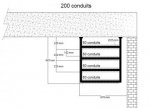I?m in a hospital project where the wire type as per specs min 4mm2 CU/XLPE/LSHF & the overall diameter for each wire 7mm, by applying table9 the allowable fill ratio will be 40% & each conduit would fit only three wires (one circuit), some of the electrical rooms receiving approximately 500 conduits & the reasoning of this large number is the application of the smart lighting control where each circuit splitted into multiple channels (at least three), appreciate your input regarding the following solutions in order to reduce the conduit number:
- Change all wires to min 4mm2 CU/PVC & that would reduce the number of conduits by 50% approximately.
- Change all wires to min 4mm2 CU/PVC for circuits & (1.5 to 2.5 mm2 CU/PVC for lighting channels) & that would reduce the number of conduits by 61% approximately.
- Maintain all wires As Per Specs to 4mm2 CU/XLPE/LSHF for circuits & (1.5 to 2.5 mm2 CU/XLPE/LSHF for lighting channels) & segregate the installation between normal and emergency wires where the normal wires will be installed in perforated cable tray size 600x150mm & the emergency wires will be installed in #200 conduits & could be reduced to #100 conduits if use CU/PVC wires. See the below installation, appreciate your patient & ideas.

- Change all wires to min 4mm2 CU/PVC & that would reduce the number of conduits by 50% approximately.
- Change all wires to min 4mm2 CU/PVC for circuits & (1.5 to 2.5 mm2 CU/PVC for lighting channels) & that would reduce the number of conduits by 61% approximately.
- Maintain all wires As Per Specs to 4mm2 CU/XLPE/LSHF for circuits & (1.5 to 2.5 mm2 CU/XLPE/LSHF for lighting channels) & segregate the installation between normal and emergency wires where the normal wires will be installed in perforated cable tray size 600x150mm & the emergency wires will be installed in #200 conduits & could be reduced to #100 conduits if use CU/PVC wires. See the below installation, appreciate your patient & ideas.


